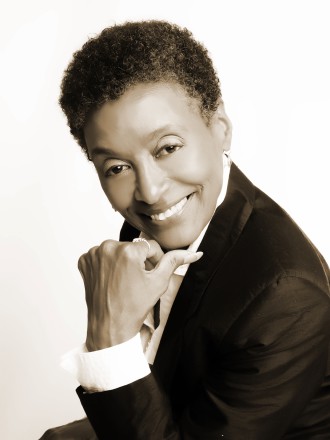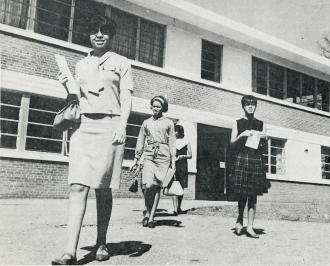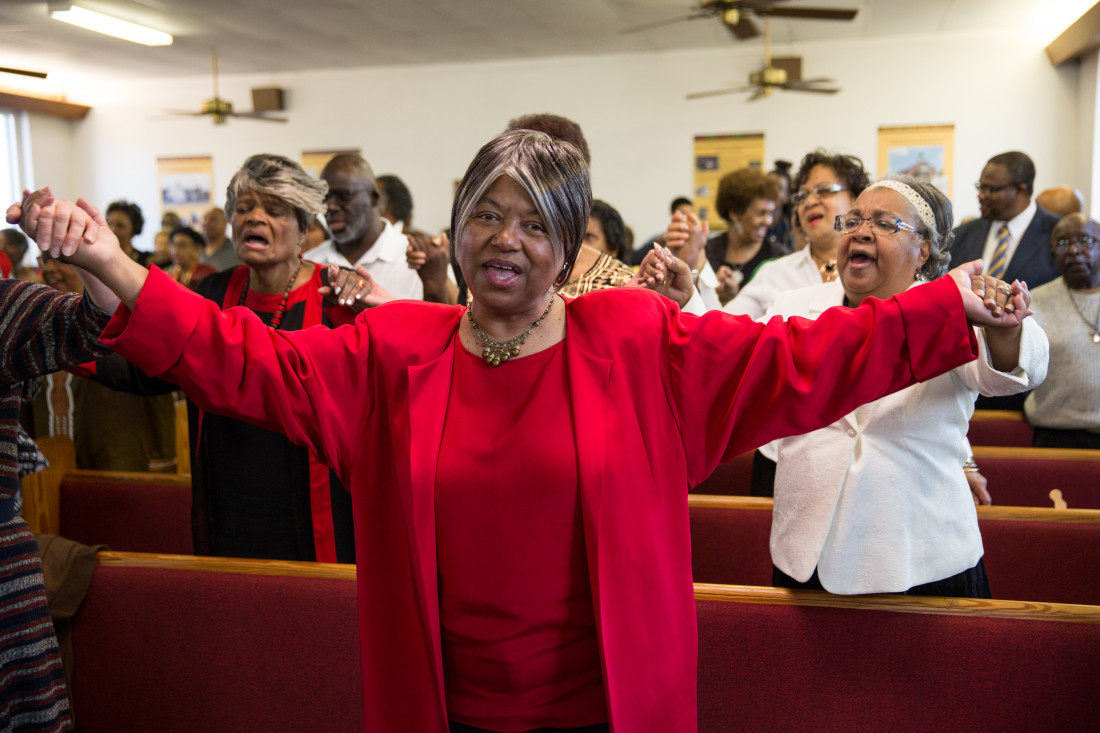In Part 1 of this series, we looked at a history of discrimination and policies, such as urban renewal, that marginalized the voices of nonwhite writers in Asheville and throughout Appalachia. Educational institutions — or lack thereof — impacted that suppression of diverse literature, including the Asheville area’s lack of a historically black college or university. And, while efforts are now being made to address diversity in education, there are still shortfalls.
Asheville High School was integrated in 1969 — nearly 50 years ago — but local author, poet and playwright Monica McDaniel says she only remembers having four black teachers when she was a student, and her teenage daughter has only had one.
At the same time, local author Meta Commerse, who recently published The Mending Time, taught for four years at an area community college but found the experience to be difficult. “I was the only woman of color,” she remembers. “It was very isolating, very challenging.”
She continues, “I had some great times overall with my students, but I definitely had, most of the time in my classes, students who pushed back. I taught true history … and they weren’t used to that.”
Lesson plans

Commerse had been hired by a well-intentioned department head to teach “in an indigenous voice,” she says, “but I don’t think either of us realized what the cost of that would be.” She had support from a few colleagues “as long as no one else was looking,” she says with a laugh.
Eventually, her health began to suffer as the stress took its toll, and Commerse resigned. She had accepted the job unaware of the all-white environment. Commerse had relocated to Asheville from Chicago, having completed her Master of Fine Arts in writing and was eager to teach but felt locked out of the university system. “The best I could get was [teaching a workshop] at the Great Smokies Writing Program,” she remembers.
Commerse, who did teach at Great Smokies this year, offers her own workshops through Story Medicine Asheville, “a program including study, indigenous modalities and writing to heal soul wounds,” according to the website.
“We started out so tiny, but with so much hope, and that little program grew,” Commerse says of the initiative she founded. “Right now, the class that’s getting the most attention is ‘Story Medicine for Racial Healing.’”
Perhaps surprising, the attendees are mostly white — “White people who are serious about transformation and are on a path to be whole human beings,” Commerse says. “When I talk to them about my work, they embrace it.” Growing interest and word-of-mouth sharing have meant Commerse has not needed to advertise.
Commerse was raised in the black art movement; her mother was an activist, teacher and writer. “I grew up in a time of unrest and a time of great change,” she says, “but also knowing there are possibilities.” But within that movement, the voices of black men were given prominence while the work of black women still remained in the background, Commerse says.
The author describes a wealth pyramid, as put forward by Howard Zinn, where African-Americans are at the bottom, “and even below them are black women,” Commerse explains. “We know she’s down there, but really she’s holding the rest of [us] up. … And if she really starts talking about her truth, the rest will be embarrassed.”
That leads to her theory about why those voices have not received adequate representation: “If we don’t want to feel [ashamed], we may have to say, ‘Well, one at a time can come, but even then, we may have to have an agreement about how honest you can be. And you certainly can’t be angry. If you’re angry, we do not want you in here.’”
It’s a painful double standard on which Commerse shines light through her work and writing — though there are still obstacles. “I work hard to produce a quality work,” she says. “I know that when I’ve been shut out, it’s less personal than it is systematic.”
Storied past
Artist and author Ann Woodford, who grew up in Andrews, recalls attending a one-room school for black children that only went to eighth grade. “If you wanted more than that, you had to leave town,” she says. It was part of an unspoken system aimed at keeping area African-Americans in positions as farmhands and domestic help.
But Woodford’s family arranged for her and her sisters to go to Allen High School, a Methodist girls boarding school in Asheville, and from there she went on to college in Ohio. After graduating, Woodford tried to find teaching work in North Carolina. “But nobody would hire me, saying I was overqualified,” she says. “A lot of blacks have gone through that kind of racial problem … if [they] had any education at all.” She served, briefly, as the first African-American teacher in the Cherokee County school system but was only hired as a “special projects” teacher rather than as full-time faculty.

Needing to make more money, Woodford pursued various career paths in California — including marketing her Charlie and Annie Ragg dolls and African Heritage Playing Cards — before returning to Western North Carolina to care for her elderly parents. “My father was a great oral historian,” she says. “He talked about all the people around Cherokee County. … He’d tell me these stories, and I thought, ‘Why isn’t somebody writing all this down?’ So I decided to start writing.”
That seed of an idea led to Woodford’s book When All God’s Children Get Together: A Celebration of the Lives and Music of African-American People in Far Western North Carolina. It took her five years to research and two to lay out, and was produced in part through a grant from the Blue Ridge Heritage Area. “I wanted people to understand we were zeroing in on a region, but it’s the story of many people across the nation,” she says. “Because [historically] teaching black people to read and write was illegal, it got to the point of doing oral history, mostly. But when the older people passed away, they took all that with them.”
She continues, “I didn’t want these people to be invisible. I wanted people to know some wonderful people existed here. All of this needed to be written down.”
The late educator and author Victoria Casey-McDonald, who grew up in Cullowhee, was similarly motivated to capture the stories of the rural black communities. She penned The African Americans of Jackson County, Just Over the Hill and Under the Light of Darkness.
As Casey-McDonald and Woodford were inspired by ancestral voices, so too was Glenis Redmond when she first arrived in Asheville. “There was freedom: Do what you want, write what you want,” she says. “But, at the same time, I felt that Asheville was somewhat disconnected from not just the [African-American] literary community, but the [African-American] community as a whole.”
She continues, “That made me look at my roots. I lived in Kenilworth [and] there was a slave cemetery. … Even though those were not my direct ancestors, they definitely were part of the narrative that was part of my collective narrative.”
The luxury of being an artist
Redmond arrived in Asheville in the ’90s. The slam poetry world “was a place I could fit in, though I consider myself more connected to the West African singing tradition,” she says. “But no one understood that.”
As a black poet — even in that era of the Green Door, the champion Asheville slam team and general poetic prominence — Redmond didn’t find an obvious niche. “I had to create space that was not those traditional spaces that kept me from my full voice,” she remembers. “That was my choice.”
Redmond was a first-generation college student in her family, and the idea of pursuing a career in the arts “was seen as irresponsible,” she says. While she knew that for herself to feel viable in the world she needed to write, “there’s a luxury to being an artist and a writer,” she says.
But that doesn’t mean the literary path is an easy one, making a supportive community imperative. Redmond recalls Patricia Johnson, “the other black woman in the poetry scene,” who would make the trip from Virginia to Green Door slams in the 1990s. She points out, however, that the rest of the region boasts a number of prominent and celebrated African-American writers: Nikki Giovani from Knoxville, Tenn., the late Maya Angelou from Winston-Salem, Jaki Shelton Green from Mebane, Randall Kenan from Chapel Hill, Nathaniel Mackey from Durham and many others.
Still, the names of fellow nonwhite artists were not enough to buffer Redmond. She once did a three-week tour of WNC and learned that the region as a whole was 99.8 percent white. She received hate mail for some of her writings. “I have a lot of mixed feelings about the mountains,” she admits. “In some places, I feel so at home as a creative spirit, but left out in a way.”
In Asheville, she says, “I felt like my volume was turned up, [but] it was turned up because I was like, ‘Does anybody hear me?’ I was loud and lonely and hurting. … I can’t imagine what it was like for those who came before me.”
Looking forward
Darin Waters, a professor of history at UNC Asheville, had been talking about the subject of black authors with Tamiko Ambrose Murray for “The Waters and Harvey Show,” (a broadcast and podcast Waters hosts with fellow UNCA professor Marcus Harvey). Ambrose Murray, who is a co-director of Asheville Writers in the Schools and Community, was a guest on Waters’ show. “My question for Tamiko was, even with the students she’s working with now, does she see the potential for a prominent writer of color — someone who will stand on par with a Thomas Wolfe as a native son?” says Waters.
There is hope for that: Young poets such as Devin Jones and Shenita Jackson have honed their skills in programs like Homeword and through mentorships with spoken-word artists such as Dewayne Barton — who founded Hood Huggers International and the Burton Street Peace Garden, among other community initiatives — and Redmond.
Other young writers are finding their voices though Word on the Street/La Voz de los Jovenes, a bilingual online arts and culture magazine and part if AWITSC’s programming, with which Ambrose Murray is also involved. The future is bright — but these burgeoning voices still need the support of the entire Asheville community.
Happily, the possibility today is a real one. But to pursue writing as a career 50 or 100 years ago was a different story. “Anybody can write, but to choose it as a profession? That’s a hard economic choice,” Redmond muses. “I think people were making those choices, no matter what, but it was a harder choice in the mountains.”
She adds, speaking to past, present and future writers, “You have to be tenacious.”
The third part in the series will be published in January.






Dear Alli, what a fantastic work you are doing to bring out the history of our people who have seemed almost invisible over my lifetime and long before I was born. I pray that this writing will start new dialogues in our region where many folks are still afraid to ask and answer questions across racial lines.
Thank you so very much!
Ann Miller Woodford